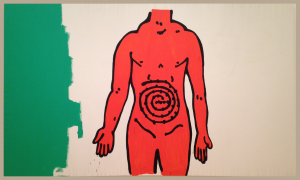
Today, August 6, is the anniversary of Andy Warhol’s birth; he would have been 90 years old.
In Baltimore last summer to visit with a friend of my father’s, I stopped by the city’s Museum of Art. What a surprise to meet Warhol’s hara painted large.
(Hara is the Japanese term for the body’s central volume as the sourcepoint for our physical, emotional, and creative energy. Bringing hara to light in contemporary terms has been the purpose of my enduring Honoring Your Belly project and the subject of The Woman’s Belly Book.)
The spiral line, with its horizontal segment at the center, indicates a sort of labyrinth. The labyrinth is an ancient symbol of the soul’s journey to the source. As I detail here, cultures throughout the world — from the Arctic to Africa — have delineated labyrinthian designs. They’ve taken a variety of forms, drawn to a variety of scales, appearing on cave walls, stone monuments, grave markers, pottery, coins, and the bellies of clay figurines.
Andy Warhol’s belly, too.
From the placard: “Warhol produced his Physiological Diagram series in the mid-1980s, a time that coincided with the outset of the public health crisis of HIV/AIDS, as well as the artist’s increasing awareness of his own aging body…. He found himself considerably weakened due to gunshot wounds sustained during a 1968 attempt on his life that left scars on this stomach. By the 1980s, he was following an exercise regimen and became interested in alternative…medical practices and related imagery, such as the chart emphasizing the abdominal region that appears in this painting.”
Happy birthday, Andy!
